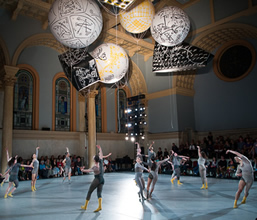Visiting orchestras in the Central Piedmont of North Carolina have become almost as rare as three-legged chickens, so any appearance within the state is a temptation. On February 15, a large audience of diverse ages filled most of Wright Auditorium on the East Carolina University Campus. With its surprisingly warm acoustics, it is one of the best venues for orchestral concerts that I know. The Hungarian National Philharmonic, formerly the Hungarian State Symphony Orchestra, has previously visited the Triangle; and a few seasons back, when he guest-conducted the visiting Hungarian State Symphony of Pecs in Danville, Virginia, we had been impressed by the solid musicianship of Zsolt Hamar, now the HNPO’s Permanent Conductor.
The highlight of the concert was a beautiful and carefully-nuanced performance of Claude Debussy’s revolutionary “Prélude à l’Après-midi d’un faune.” Hamar secured remarkably quiet playing from all sections of the orchestra. Principal Anita Szabó, opening with an ideal “pp” flute solo, was shortly joined by oboist József Kiss. The subtle blend of the “pp” horn section with harps backing the woodwinds was memorable. This was the finest performance of the work that I have heard in the region to date.
Less than immaculate execution of the opening series of bravura octave passages by piano soloist Károly Mocsári did not bode well for Franz Liszt’s First Piano Concerto, in E-flat Major. Whether due to a hasty, last-minute introduction to this particular piano or to fingers stiff from the weather turning colder, these flaws were soon surmounted in a performance with greater poetic sensitivity than is normally heard in a work more often exploited as a showpiece for steel-fingered virtuosity. Hamar provided ideal accompaniment. Mocsári’s second movement was particularly sensitive. Zsolt Szatmári provided the eloquent clarinet solo; the player of the famous triangle was unidentified. Concertmasters were rotated, with each serving for half of the concert.
A good standard interpretation of Tchaikovsky’s Symphony No. 4 in F Minor, Op. 36, brought the audience to its feet at the end of the concert. All sections of the orchestra played well. An apt touch of vibrato in the horns was stylish and welcome, and the woodwinds were marvelous. The somewhat small string section produced a good, full sound. Orchestral dynamics were carefully considered and there were nice individual touches. Hamar had a firm grasp of the work as a whole and subordinated each movement to make a very satisfying complete view of the old warhorse. Thank God the over-programmed Fifth Symphony wasn’t selected! Fear of the impending ice storm led to quick flight before any possible encore.
With more than a dozen Mozart piano concertos seldom played, it always surprises me to find the less rewarding Liszt concertos programmed so often. While not wishing to be a narrow nationalist, it would have been even better if the Hungarians had showcased some of their other wonderful composers such as Bartók, Kodály, or even Dohnányi.
All praise for the completion of the 264 By-pass around Wilson, which ought to make the Alexander Performing Arts Series – as well as ECU’s many Music Department programs – more readily accessible to Raleigh’s music lovers. I await the next segment of 440, Raleigh’s Outer Beltline.












